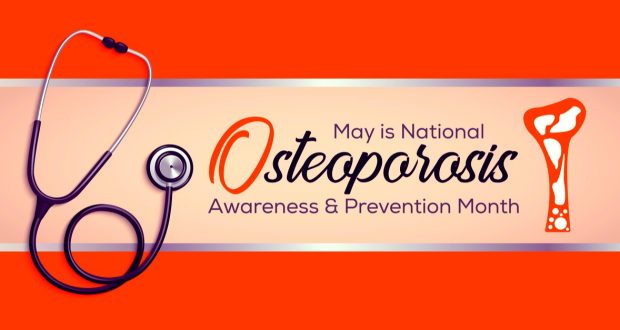By: Red Hot Mamas
Published: May 11, 2021
Every May, the National Osteoporosis Foundation (NOF) observes Osteoporosis Awareness Month as a way to highlight the importance of good bone health. Maintaining bone strength is important for everyone, but especially for postmenopausal women.
Bones are in a constant state of renewal—new bone is made, and old bone is broken down. As you age, bone tissue (or bone mass) is lost faster than it is created, often resulting in osteoporosis.
Bone loss can increase the risk of fracture
The word osteoporosis means “porous bone.” It causes bones to become thin, weak, and brittle. Bone loss can increase the risk of fracture from a fall or even from simple activities such as bending over or coughing. The good news is that osteoporosis can be prevented and treated, so these unfortunate events are less likely to happen. We cover some of those preventive measures below.
Menopause is a major risk factor for osteoporosis
Osteoporosis is more common in women than in men. In fact, 1 in 2 women aged older than 50 years will break a bone due to osteoporosis, while only 1 in 4 men will do so. For most women, bone loss increases after menopause when estrogen levels drop sharply. Furthermore, in the 5 to 7 years after menopause, women can lose 20% or more of their bone density (thickness). Even though there are no obvious signs that your bones are weakening—it is often called a “silent disease”—you should ask your doctor about it while discussing more obvious menopause symptoms, such as hot flashes, which often result from decreased estrogen.
Diagnosing osteoporosis
Many doctors recommend a bone mineral density (BMD) test—the most common of which is a dual energy X-ray absorptiometry (DEXA) scan—for their patients who have reached menopause. Using an instrument that measures the amount of mineral in an area of bone (often the spine and hip), this test can predict how susceptible your bones are to fracture. Armed with this knowledge, your doctor can recommend preventive measures and/or treatment options. Because it is a disease that can be prevented and treated, an early diagnosis can make a difference.
Preventing osteoporosis
Medications, good nutrition, and regular weight-bearing exercise can help prevent bone loss and/or strengthen already weak bones. Talk to your doctor about your dietary needs, approval of an exercise program, and whether you need medication.
Nutrition
Eat a healthy, well-balanced diet rich in calcium and vitamin D
Calcium helps build strong bones, and vitamin D helps your body absorb it
Good sources of calcium include dairy products and dark leafy greens. Also, some products, such as orange juice, cereals, and even bottled water, are fortified with calcium
You can get some of your vitamin D from sunlight. Your body produces it when exposed to the sun and stores it in fat for later use
Vitamin D food sources include fatty fish, such as tuna or salmon, milk, orange juice, and fortified cereals
If you are not able to get all the calcium and vitamin D that you need from natural sources, speak with your doctor about taking supplements
Avoid smoking, and limit alcohol to 2 drinks per day
Exercise
Work with your doctor to develop a plan for weight-bearing, strength-training, and balance exercises. All have been shown to improve the health of your bones and decrease the risk of falls.
Weight-bearing exercises involve carrying your body weight, and include walking, running, climbing stairs, skipping rope, playing tennis, and dancing
Strength training can be done at the gym with weight machines or at home with resistance bands and/or free weights
Practice balance with gentle yoga or tai chi, both of which also improve muscle strength and flexibility
To maintain bone strength, aim for 45 to 60 minutes of exercise 3 times a week
Vary your exercise routine to stay interested
Treatment
In addition to these preventive measures, there are medications for women that can help prevent postmenopausal osteoporosis. Learn about a treatment option for postmenopausal women here.
Osteoporosis and COVID-19
The rampant spread of the deadly coronavirus that causes COVID-19 over the last 1.5 years has made preventing and managing osteoporosis more challenging. Gyms have been closed, which prevented some people from getting enough exercise important for building bone strength. Medical offices have been closed or on limited hours, reducing patients’ access to health care providers and BMD scans. Here are some tips to address these issues:
Talk to your doctor about getting the COVID-19 vaccine as soon as possible
Maintain your exercise and healthy eating habits as effectively as you are able to.
Now that outdoor temperatures are rising, there are more opportunities to exercise outside. A brisk walk or hike can be an enjoyable way to build up bone strength and get your vitamin D
Keep your doctor appointments, especially if you are on a medication requiring in-office administration. If you are concerned about in-person visits, ask for at-home appointments
If you are on oral medications or ones that do not require office visits, make sure that you have an adequate supply
Menopause And You
To learn more about menopause in general; the symptoms and health risks associated with it, including osteoporosis; and how each woman’s experience is different, visit menopauseandyou.com.
Join Our Red Hot Mamas Community
Visit redhotmamas.org for menopause education and support resources, including our panel of experts standing by to answer your menopause-related questions. And, check out our community of amazing postmenopausal women at inspire.com, who support, advise, and cheer each other on in real time.

BAYER and the Bayer Cross are registered trademarks of Bayer.© 2021 Bayer. All rights reserved. PP-UN-WHC-US-0027-1
 Red Hot Mamas In Charge of Change.
Red Hot Mamas In Charge of Change.




